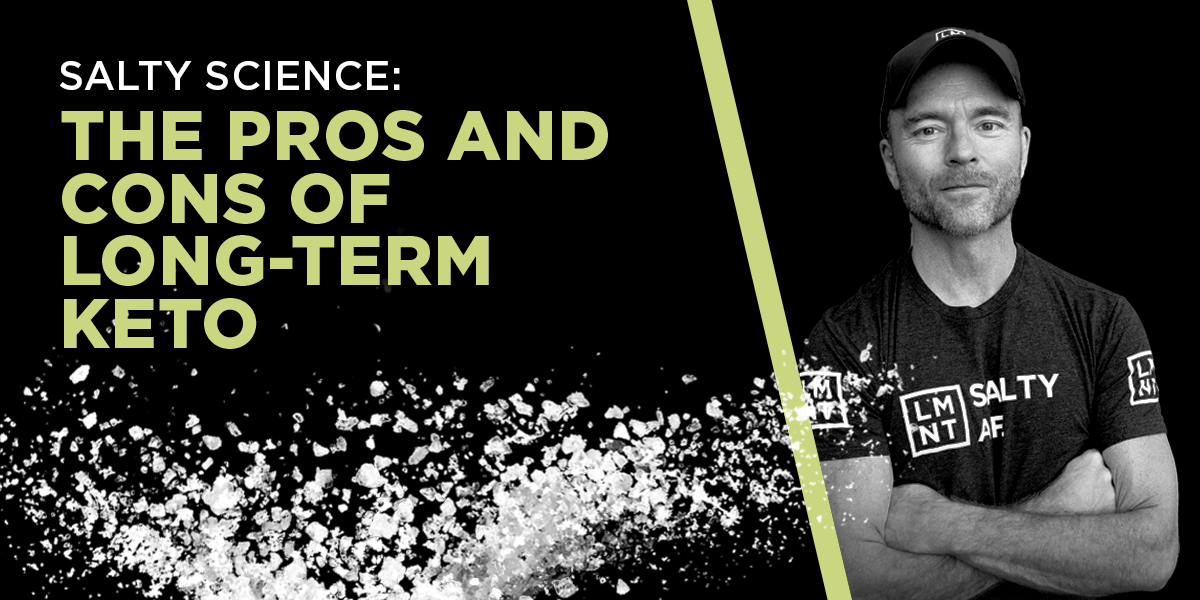I’ve been eating low-carb for more than two decades. Personally, I feel and perform my best on a keto diet, both cognitively and physically. Better digestion, better blood sugar control, and less brain fog are just a few of the benefits I’ve experienced. And interestingly, long-term ketosis may also be therapeutic for diabetes, mitigate the risks of certain cancers, and help treat or prevent various neurodegenerative diseases (it certainly helps my Essential Tremor for example).
Why not stay in ketosis all the time, then? The short answer is: It depends on your unique physiology and lifestyle. For some, it’s a great idea. For others, a seasonal “toe dip” into ketosis works wonders. And yet, some people don’t benefit from a low-carb approach at all. So despite all of the ketogenic diet’s proven benefits and my anecdotal experience with it, I don’t recommend it for everyone.
No, I view ketosis as a tool to use only so long as it’s working for you. With that established, this article will explain why the Standard American Diet creates issues, how the ketogenic diet works to combat them, and the long-term pros and cons of keto. Then, you can use that information to decide whether or not keto is a good fit for you.
The Problem with the Standard American Diet (SAD)
The Standard American Diet (SAD) is abundant in carbohydrates—especially calorie-dense processed foods which are easy to overeat. And when one consumes an excess of empty calories like these, they cannot be put to use by the body in the short term. Instead, they’re sent to the liver to be stored as glycogen (our body’s stored form of glucose).
The problem? Glycogen stores are limited. When they fill up, excess glucose has nowhere to go but to be converted into triglycerides and stored in our fat cells. As an added consequence, as we continue to overeat, blood sugar and insulin levels stay chronically elevated. That marks the beginning of a downward spiral that may eventually result in type 2 diabetes and a host of other metabolic issues.
The omnipresence of carbohydrates in the modern diet prevents ketosis. You see, carbs are our body’s preferred source of fuel. When they’re available, they are utilized first and foremost—before body fat, muscle, or anything else. But what happens when you restrict carbohydrate intake significantly, and your body doesn’t have any simple sugars to rely on anymore?
How Does the Ketogenic Diet Work?
To support our brain and body in the absence of carbs, the liver unlocks a wealth of stored energy. It breaks down fat, releasing the fatty acids needed to produce an alternative form of fuel called ketones. In other words, when you limit carbohydrate intake to between 25 and 50 grams per day, you enter a state of ketosis.
Our long lost ancestors remained in ketosis frequently. They didn’t always have access to carbohydrates, nor a consistent eating schedule. Ketones provided much needed brain fuel when glucose was scarce.
These days, ketosis is less about survival and more about reversing the effects of the Standard American Diet. Limiting carb intake and fasting are the two main ways people enter a state of ketosis, and these methods can be used for both weight loss and a variety of therapeutic purposes.
I’ve been saying it for years: sustainable weight loss isn’t just a game of calories in, calories out. The state of your metabolism, hunger hormones, nutrient density, and gut health matter too. A ketogenic diet can get many of these areas moving in the right direction rather quickly.
Therapeutic Applications of Nutritional Ketosis
The ketogenic diet was originally developed in the 1920s to treat childhood epilepsy. Researchers noticed that, at higher ketone levels, children would have fewer and milder seizures. Since then, ketosis has shown promise in many other facets of health. I’ll review the top four now.
#1: Weight loss
Keto’s best known benefit is weight loss. And while it’s not the only diet that works for this purpose, it’s undoubtedly an effective one.
There are dozens of keto weight loss studies to choose from, but I like to cite a 2003 randomized controlled trial from the Journal of Clinical Endocrinology and Metabolism. In the study, obese women lost more weight on a ketogenic diet than controls lost on a calorie restricted, low-fat diet.
The most interesting facet of this study, however, is that the women who ate a ketogenic diet weren’t told to limit calories—yet they still cut calories in-line with the calorie restricted group. This makes sense when you understand that a keto diet helps regulate hunger hormones like ghrelin and leptin. Less hunger, less overeating, less weight gain.
#2: Diabetes
I’m baffled—flabbergasted, even—that the ketogenic diet isn’t standard of care for type 2 diabetes. A recent consensus report in the journal Diabetes Care pegged low-carb diets as the intervention with the “most evidence” for combating high blood sugar. This claim is supported by the Virta Health study, a year-long intervention in which a supervised keto diet was shown to reverse diabetes (as measured by HbA1c) for the majority of 218 type 2 diabetics.
#3: Neurodegeneration
As we age, our brains get worse at using glucose. This may contribute to cognitive decline and certain types of Alzheimer’s disease.
The aging process, however, doesn’t seem to affect ketone utilization, which is one reason why researchers are excited about ketosis for dementia prevention and mitigation. Supplementing with MCT oil (a highly ketogenic fat) seems especially promising.
#4: Cancer
In the 1920s, Otto Warburg discovered that cancer cells run primarily on glucose. This finding, now dubbed “The Warburg Effect,” has seen a resurgence lately as researchers explore metabolic therapies (like ketosis) for cancer.
Cancer cells love elevated blood sugar and insulin levels, and the keto diet minimizes both of these biomarkers. Bad news for cancer, good news for people. Stay tuned on this one. Lots of research is underway.
The Data on Long-Term Keto
Keto is one of the most studied diets on the planet, but don’t expect any 5 or 10 year keto vs. Mediterranean diet trials anytime soon. It’s super expensive and super challenging to do nutrition research for that length of time. It isn’t likely that we’ll get to see these long-term studies.
What about epidemiology? Well, the traditional Inuit lived in fairly good health on diets full of blubber and free of carbs. But the Inuit, researchers speculate, have genetic adaptations to help them process fat more efficiently. Long-term keto for the Inuit? Not the same as long-term keto for the general population.
And so, whether or not keto is the “best” long-term diet for you depends on your unique physiology and therapeutic goals. And permanent ketosis is not entirely without risk.
Long-Term Keto: Potential Risks
For people like me, keto may be the ideal diet for the long haul. For others, it may be better to limit carbs for shorter periods (perhaps several months) as a means to lose weight. To make this distinction for yourself, it’s wise to keep an eye on potential downsides of long-term keto. To my eye, the main problem areas tend to be:
- LDL-P. A subset of folks see a large spike in LDL particle number (LDL-P) after switching to a ketogenic diet. Since high LDL-P—which is also tracked by a marker called ApoB—is correlated with increased heart disease risk, it’s worth keeping an eye on this biomarker. If you’re an LDL-P “hyper-responder,” so to speak, it’s probably better to be safe than sorry and bump up your carbohydrate intake.
- Certain exercises. Many elite athletes thrive on a keto diet, but there are certainly those who don’t. High-intensity activities (like Crossfit, HIIT, and obstacle races) as well as longer efforts (such as marathons) will require extra glucose for energy. Adding back carbs in a ratio that supports your exercise regimen is the answer.
- Gut health. A ketogenic diet tends to be low in soluble fiber, and for most folks, a long-term lack of fiber is a net negative. Gut bacteria likes to munch on soluble fiber to create compounds like butyrate that reduce inflammation and strengthen the gut barrier. But in some cases, a low-fiber diet can be a good thing—it’s a matter of your unique gut. To make up for a lack of fiber in a ketogenic diet, the amino acids in protein can assist production of short chain fats which feed the gut, much like fiber from plants. This does NOT mean that keto and carnivore are the best option for everyone, everywhere—but it does make it pretty tough to claim that keto is inherently bad for gut health.
How To Bring Back Carbs
In my book, Wired to Eat, I lay out what I believe to be the optimal long-term diet (for folks that fit the mold, so-to-speak). For the detailed explanation you’ll have to read the book. But to simplify and summarize: it’s basically a mix of healthy fats, plenty of protein, and 50–150 grams of paleo-friendly carbs per day.
If you’re used to eating keto and want to ease back into carbs, you’re probably wondering how to do it, and with what kinds of foods. In my experience, it’s best to test the waters
While using a blood glucose monitor, eat 25–50 grams of carbs from a single healthy source—like sweet potatoes, fruit, legumes, or white rice—in one sitting. Monitor the change in your blood glucose levels over the following two hours. The next day, repeat this experiment with a different source of carbs. Your goal is to identify which foods result in the smallest blood sugar bump 1 or 2 hours after eating.
Your gut should also guide you. Rice makes me feel like a clown is inflating balloons in my intestines, but berries sit fine with me. Don’t give up after one gassy failure—this may require some experimentation.
Ketosis Is A Tool
Is keto the best long-term diet? That’s a loaded question. We’re far too variable of a species to make broad-reaching claims like that, and I suggest avoiding any literature that claims otherwise.
Most humans throughout the course of history weren’t in ketosis permanently; they cycled in and out. I think the cyclical approach is probably a wise one. Enter ketosis for the health benefits when it’s timely, then have some carbs to refuel glycogen tanks, feed gut bacteria, and upregulate LDL particle clearance.
And as always, listen to your body. Nothing matters more than how you look, feel, and perform. Speaking of feeling your best on a ketogenic diet, the most common mistake people make with a low-carb, whole foods regimen is not consuming enough sodium. To learn more about why, read this article.

